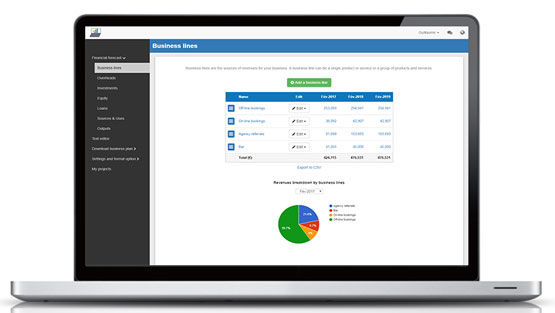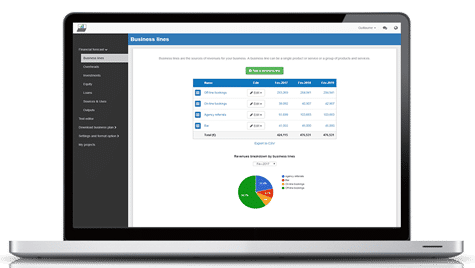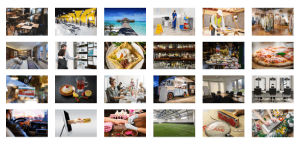How to open a bottled water brand?
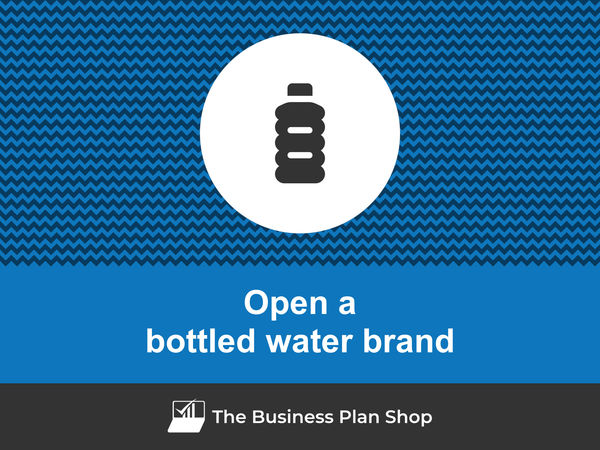
Are you keen to open a bottled water brand but don't know where to begin? Then you're in luck because this guide will lead you through all the steps required to check if your business idea can be profitable and, if so, turn it into a reality.
Our guide is for prospective entrepreneurs who are thinking about starting a bottled water brand no matter how far they are in their journey - whether you’re just thinking about it or in the middle of market research this guide will be useful to you.
Think of this as your blueprint: we cover everything you need to know about opening a bottled water brand and what key decisions you’ll need to make along the way.
Ready? Let’s get started!
Learn how a bottled water brand works
Before you can start a bottled water brand, you need to have a solid understanding of how the business works and what are its main revenue streams.
This will give you a glimpse into the profitability potential of your venture, whilst allowing you to decide whether or not it is a good fit for your situation (current skill set, savings and capital available to start the business, and family responsibilities).
It may be that creating a bottled water brand is an excellent idea, but just not the right one for you.
Before starting their own company, successful entrepreneurs typically:
- Consult with and take advice from experienced bottled water brand owners
- Acquire hands-on experience by working in an operational bottled water brand
- Take relevant training courses
Let's explore each option in a bit more detail.
Consulting with and taking advice from experienced bottled water brand owners
Having "seen it all", established business owners can offer valuable insights and hands-on advice drawn from their own experiences.
This is because, through both successes and failures, they've gained a more informed and practical understanding of what it takes to build and sustain a successful bottled water brand over the long term.
Acquiring hands-on experience by working in an operational bottled water brand
If you want to open a bottled water brand, having industry-specific experience is imperative because it equips you with the knowledge, network, and acumen necessary to navigate challenges and make informed decisions critical to the success of your future business.
You'll also be able to judge whether or not this business idea is suitable for you or if there might be conflicts of interest with your personal life (for example, long working hours could be incompatible with raising young children).
This work experience will also help you to make contacts in the industry and familiarise yourself with customers and their expectations, which will prove invaluable when you set up your bottled water brand.
Take relevant training courses
Taking a training course is another way of familiarising yourself with the business model of your future activity before you decide to make the jump.
You may choose to complete a training course to obtain a certificate or degree, or just take online courses to acquire practical skills.
Before going any further in setting up your venture
Before you go any further with your plans to open a bottled water brand, make sure you have a clear vision of what it will take in terms of:
- What skills are needed to run the business successfully (do you have some or all of these skills?)
- What a standard working week looks like (does it suit your personal commitments?)
- What sales potential and long-term growth prospects the bottled water brand has (compare this with your level of ambition)
- What options you'll have once you decide to retire (or move on and inevitably sell the company)
This analysis of the business model and the constraints of the business should help you to check that your idea of launching a bottled water brand fits your entrepreneurial profile.
If there is a match, it will then be time to look at assembling the founding team of your business.
Assembling your bottled water brand's founding team
The next step to opening your bottled water brand is to think about the ideal founding team, or to decide to go in alone.
Starting and growing a successful business doesn't have to be a solo journey and setting up a bottled water brand with several co-founders is generally easier. The business benefits from a management team with a wider skillset, decisions are made together, and the financial risk is shared among the partners, making the journey more collaborative and less daunting.
But, running a business with several partners brings its own challenges. Disagreements between co-founders are quite common, and these can pose risks to the business. That's why it's crucial to consider all aspects before starting your own business.
We won't go into too much detail here, as this is a complex topic that deserves its own guide, but we do recommend that you ask yourself the following questions:
- What is the ideal number of co-founders for this venture?
- Are you on the same wavelength as your potential partners in terms of vision and ambition?
- How will you deal with potential failure?
Let's look at each of these questions in more detail.
What is the ideal number of co-founders for this venture?
To answer this question you will need to consider the following:
- What skills do you need to run the business? Are you lacking any?
- How much startup capital do you need? How much do you have?
- How are key decisions going to be made? - It is usually advisable to have an odd number of partners (or a majority shareholder) to help break the tie.
Put simply, your co-founders contribute skills, capital, or both. Increasing the number of partners becomes advantageous when there is a deficiency in either of these resources.
Are you on the same wavelength as your potential partners in terms of vision and ambition?
Your business partners should share the same short and long-term vision, be it business expansion or social responsibility, to avoid future frustrations and simplify decision-making. Different views are natural, but alignment is ideal.
In any case, you should think of having an exit mechanism in place in case one of the partners wants to move on.
How will you deal with potential failure?
We wish you nothing but success when starting up and growing your bottled water brand, but it's always wise to have a backup in case things don't go as planned.
How you deal with a potential failure can vary significantly based on the relationship you have with your business partner (close friend, spouse, ex-colleague, etc.) and the personal circumstances of each of you.
For instance, starting a business with your spouse might seem appealing, but if it doesn't succeed, you risk losing 100% of the household income at once, which could be stressful.
Similarly, going into a partnership with a friend can put pressure on the friendship in the event of failure or when you need to make difficult decisions.
There is no wrong answer, but it is essential to carefully evaluate your options before starting up to ensure you're well-prepared for any potential outcomes.
Conducting market research for a bottled water brand
The next step in launching a bottled water brand is to carry out market research. Let's take a look at what this involves.
The objectives of market research
The objective here is very simple: to assess the level of demand for your business and whether there is an opportunity for it to thrive in your chosen location.
The first step will be to check that the market is not saturated with competing offers and that there is room for a new player: your bottled water brand.
Your market analysis will also help you identify a concept and market positioning that has every chance of being successful in your target market, thereby helping increase your business's chances of success.
Carrying out market research for your bottled water brand will also enable you to better understand the expectations of your future customers and the most effective ways to communicate with them in your marketing plan.
Analyse key trends in the industry
Your market research should start with an industry analysis in order to gain a good understanding of the main players and current trends in your sector.
Once you've delved into the current state of the market, it will be time to assess what proportion of your target market can be seized by your bottled water brand. To do this, you will need to consider both the demand and supply side of the market.
Assess the demand
After checking out the industry, let's shift our focus to figuring out what your potential customers want and how they like to buy.
A classic mistake made by first-time entrepreneurs is to assess demand on the global or national market instead of concentrating on their target market. Only the market share that can be captured by your company in the short term matters.
Your demand analysis should seek to find answers to the following questions:
- Who are your target customers?
- How many are there?
- What are their expectations?
- What are their buying habits?
- How much budget do they have?
- What are the different customer segments and their characteristics?
- What are the main distribution channels and means of communication for reaching each segment?
The aim of the demand analysis is to identify the customer segments that could be targeted by your bottled water brand and what products and services you need to offer to meet their expectations.
Analyse the supply side
You will also have to familiarize yourself with the competing bottled water brands on the market targeted by your future business.
Amongst other things, you’ll need to ask yourself:
- Who are the main competitors?
- How many competitors are already present?
- Where are they located?
- How many people do they employ?
- What is their turnover?
- How do they set their prices?
- Are they small independent businesses or national players?
- Do they seem to be in difficulty or are they flourishing?
- What is their market positioning?
- What types of products and services do they offer?
- What do customers seem to like about them?
The aim of the competitive analysis is to identify who your competitors will be and to gather information that will help you find a differentiating commercial positioning (more on that later in this guide).
Regulations
Conducting market research is also an opportunity to look at the regulations and conditions required to do business.
You should ask yourself the following questions:
- Do you need to have a specific degree to open a bottled water brand?
- Do you need specific licences or permits?
- What are the main regulations applicable to your future business?
Given that your project is at an early stage, your focus should be to ensure that there are no roadblocks from a regulatory standpoint before you deep dive into the planning process.
Once your project is more advanced, you will have the opportunity to talk about regulation more in-depth with your lawyer.
Concluding your market research
By the time your market research is completed, you should have either:
- Pinpointed an untapped business opportunity,
- Or arrived at the realisation that the market is saturated, prompting the search for alternative business ideas or models.
If the conclusion is that there is an opportunity in the market to cater to one or more customer segments currently underserved by competitors, that's great!
Conversely, if you come to the conclusion that the market is already saturated, don’t panic! The good news is that you won’t spend several years working hard on a project that has little chance of success. There is no shortage of business ideas either - at The Business Plan Shop, we have identified more than 1,300 potential business ideas!
Choosing the right concept and positioning for your bottled water brand
Once your market research is completed, it's time to consider the type of bottled water brand you want to open and define precisely your company's market positioning in order to capitalise on the opportunity you identified during your market research.
Market positioning refers to the place your product and service offering occupies in customers' minds and how they differ from competing products and services. Being perceived as the premium solution, for example.
There are four questions you need to consider:
- How will you compete with and differentiate yourself from competitors already on the market?
- Is it better to start or buy a bottled water brand already in operation?
- How will you validate your concept and market positioning?
Let's look at each of these in a little more detail.
How will you compete with and differentiate yourself from competitors already on the market?
When you choose to start up a bottled water brand, you are at a disadvantage compared to your rivals who have an established presence on the market.
Your competitors have a reputation, a loyal customer base and a solid team already in place, whereas you're starting from scratch...
Entering the market and taking market share from your competitors won't happen automatically, so it's important to carefully consider how you plan to establish your presence.
There are four questions to consider here:
- Can you avoid direct competition by targeting a customer segment that is currently poorly served by other players in the market?
- Can you offer something unique or complementary to what is already available on the market?
- How will you build a sustainable competitive advantage for your bottled water brand?
- Do you have the resources to compete with well-established competitors on your own, or would it be wiser to explore alternative options?
Also, think about how your competitors will react to your arrival in their market.
Is it better to start or buy a bottled water brand already in operation?
An alternative to opening a new business is to take over a bottled water brand already trading.
Purchasing an existing bottled water brand means you get a loyal customer base and an efficient team. It also avoids disrupting the equilibrium in the market by introducing a new player.
A takeover hugely reduces the risk of the business failing compared to starting a new business, whilst giving you the freedom to change the market positioning of the business taken over if you wish.
This makes buying an existing bottled water brand a solid alternative to opening your own.
However, buying a business requires more capital compared to starting a bottled water brand from scratch, as you will need to purchase the business from its current owner.
How will you validate your concept and market positioning?
Regardless of how you choose to establish your business, it's crucial to make sure that the way you position your company aligns with the expectations of your target market.
To achieve this, you'll have to meet with your potential customers to showcase your products or services and get their feedback.
Explore the ideal location to start your bottled water brand
The next stage in our guide on how to start a bottled water brand: choosing where to set up shop.
Setting up your business in the right location will have a direct impact on your chances of success, so it's a good idea to think things through before you launch.
To help you decide where to set up your business, we recommend considering the following factors:
These criteria will need to be refined according to the specific features of your project.
After weighing the factors mentioned earlier, it's crucial to focus on your startup's budget. Look for a location that suits your business needs while being affordable, especially in the short term.
One of the issues that will also come up is the long-term future of your location, particularly if you opt to rent your premises rather than buy. In this case, you will need to consider the conditions for renewing the lease (duration, rent increases, etc.).
Lease agreements vary widely from country to country, so make sure you check the terms applicable to your situation and have your lawyer review your lease before you sign.
What legal form should I choose for my bottled water brand?
The next step to start a bottled water brand is to choose the legal form of your business.
The legal form of a business simply means the legal structure it operates under. This structure outlines how the business is set up and defines its legal obligations and responsibilities.
Why is your bottled water brand's legal form important?
Choosing the right legal form for your bottled water brand is important because this will affect:
- Taxation: your tax obligations depend on the legal structure you choose, and this principle applies to both personal income tax and business taxes.
- Risk exposure: some legal structures have a legal personality (also known as corporate personality) and limited liability, which separates them from the owners running the business. This means that the business would be liable rather than the owners if things were to go wrong (lawsuit, debt owed in case of bankruptcy, etc.).
- Decision-making and governance: how you make key decisions varies based on the legal form of your business. In some cases you might need to have a board of directors and organise general assemblies to enable shareholders to influence major decisions with their voting rights.
- Financing: securing funding from investors requires you to have a company and they will expect limited liability and corporate personality to protect them legally.
- Paperwork and legal formalities: the legal structure you select determines whether certain obligations are necessary, such as producing annual accounts, or getting your books audited.
Popular business legal forms
The specific names of legal structures vary from country to country, but they usually fall within the two main categories below:
- Individual businesses
- Companies
Individual businesses
Individual businesses, like sole traders or sole proprietorships, are made for self-employed entrepreneurs and freelancers rather than businesses which employ staff.
They benefit from straightforward administrative requirements, minimal paperwork to start, simpler tax calculations, and streamlined accounting procedures.
However, the downside is that there's typically no legal distinction between the business and the person responsible for day-to-day operations. This means the owner's personal assets are at risk if the business faces problems or goes bankrupt.
There is also no share capital in such a structure, meaning that individual businesses cannot raise equity from investors which seriously limits funding options.
Companies
Companies are versatile structures suited to projects of all sizes in terms of number of founders, number of employees and amount of capital.
They are a bit more complex to operate than individual businesses with more formalities, stringent accounting requirements, more complex tax implications, etc.
In return, they offer stronger protections to their shareholders. They usually benefit from having their own legal identity and limited liability, meaning co-founders and investors can only ever lose the amount of money they have put into the company.
For instance, if things were to go south (the company files for bankruptcy or there is a legal issue), the company would take the hit, safeguarding the personal assets of the founders and investors.
How should I choose my bottled water brand's legal structure?
Deciding on a legal form is easy once you've estimated your sales, decided whether or not you need employees and figured out the number of co-founders joining you.
It's essential to remember that a solid business idea will succeed no matter which legal structure you pick. Tax laws change regularly, so you can't rely on specific tax advantages tied to a particular structure when starting a business.
A proven approach is to look at what legal structures your top competitors are using, and go with the most common option as a working assumption. Once your idea is mature enough, and you're getting closer to officially registering your business, you can get advice from a lawyer and an accountant to confirm your choice.
Can I switch my bottled water brand's legal structure if I get it wrong?
Yes, changing your legal structure later is possible, though it may involve selling the old entity to a new entity in some cases, which adds further expenses. If you want to save on such costs, it makes sense to pick the correct legal form for your business the first time around.
Calculating the budget to open a bottled water brand
The next step to opening a bottled water brand involves thinking about the equipment and staff needed to launch and run your business on a day-to-day basis.
Each project has its own characteristics, which means that it is not possible to estimate the budget for opening a bottled water brand without building a complete financial forecast.
So be careful when you see estimates circulating on the Internet. As with all figures, ask yourself these questions:
- Is my project similar (location, concept, size, etc.)?
- How recent is the information?
- Is it from a trustworthy source?
Startup costs and investments to open a bottled water brand
For a bottled water brand, the initial working capital requirements and investments may include the following elements:
- Bottling Equipment: This includes machinery and equipment used in the bottling process such as filling machines, capping machines, labeling machines, and conveyor belts.
- Water Source Development: This includes expenses related to finding and developing a reliable water source for your bottled water brand, such as drilling wells, purchasing land, and installing water treatment systems.
- Packaging Materials: This includes the cost of purchasing bottles, caps, labels, and other packaging materials for your bottled water brand.
- Bottled Water Delivery Vehicles: This includes the cost of purchasing or leasing vehicles for delivering your bottled water to retailers or customers.
- Bottled Water Storage Tanks: This includes the cost of purchasing or leasing storage tanks for holding your bottled water before it is distributed.
Of course, you will need to adapt this list to your company's specific needs.
Staffing plan to operate a bottled water brand
To establish an accurate financial forecast for your bottled water brand, you will also need to assess your staffing requirements.
The extent to which you need to recruit will of course depend on your ambitions for the company's growth, but you might consider recruiting for the following positions:
Once again, this list is only indicative and will need to be adjusted according to the specifics of your bottled water brand.
Other operating expenses required to run a bottled water brand
You also need to consider operating expenses to run the business:
- Staff costs: Includes salaries, benefits, and training for your employees who work in production, distribution, sales, and administration.
- Accountancy fees: Hiring an accountant to manage your financial records and ensure compliance with tax laws and regulations.
- Insurance costs: Protecting your business and assets with liability insurance, product liability insurance, and property insurance.
- Software licenses: Purchasing licenses for software programs used in production, inventory management, sales, and accounting.
- Banking fees: Charges associated with maintaining a business bank account, such as monthly fees and transaction fees.
- Marketing and advertising: Promoting your brand through various channels, such as social media, print ads, and sponsorships.
- Packaging materials: Purchasing bottles, caps, labels, and other materials needed for packaging your bottled water.
- Distribution expenses: Costs associated with transporting and delivering your bottled water to retailers and customers.
- Utilities: Paying for electricity, water, and other utilities used in your production and office facilities.
- Rent: Leasing a production facility, warehouse, or office space for your business operations.
- Raw materials: Purchasing water, plastic, and other materials needed for producing your bottled water.
- Taxes and licenses: Paying business taxes and obtaining necessary licenses and permits to operate your bottled water brand.
- Maintenance and repairs: Covering costs for repairing and maintaining equipment and machinery used in production.
- Travel expenses: Reimbursing employees for business-related travel, such as attending trade shows or meeting with suppliers.
- Sampling and testing: Conducting tests and quality control measures to ensure the safety and quality of your bottled water.
This list will need to be adapted to the specifics of your bottled water brand but should be a good starting point for your budget.
How will I promote my bottled water brand's?
The next step to starting a bottled water brand is to think about strategies that will help you attract and retain clients.
Consider the following questions:
- How will you attract as many customers as possible?
- How will you build customer loyalty?
- Who will be responsible for advertising and promotion? What budget can be allocated to these activities?
- How many sales and how much revenue can that generate?
Once again, the resources required will depend on your ambitions and the size of your company. But you could potentially action the initiatives below.
Your bottled water brand's sales plan will also be affected by variations in consumer demand, like changes in activity during peak holiday seasons, and the dynamics within your competitive environment.
Build your bottled water brand's financial forecast
The next step to start your bottled water brand: putting your financial projections together.
What is the financial forecast for a bottled water brand?
A forecast is a quantified decision-making document that shows the initial investment required to open a bottled water brand and the company's potential profitability and cash flow generation over the next 3 to 5 years.
As you think about your bottled water brand idea, the main role of financial projections will be to help you decide whether it makes sense to create the company.
Building a financial forecast helps determine the amount of initial financing required to start your bottled water brand.
In fact, creating financial projections is the only way to assess the amount of initial financing you'll need to open your bottled water brand, and to make sure your project makes economic and financial sense.
Keep in mind that very few business ideas are financially viable. At The Business Plan Shop, we've seen nearly a million business start-up ideas, and we estimate that less than one in four is economically viable.
Your forecast will therefore require your full attention and constant revision, as your project matures. It's also a good idea to simulate different scenarios to anticipate several possibilities (what happens if your sales take longer than expected to ramp up, for example), so you're ready for all eventualities.
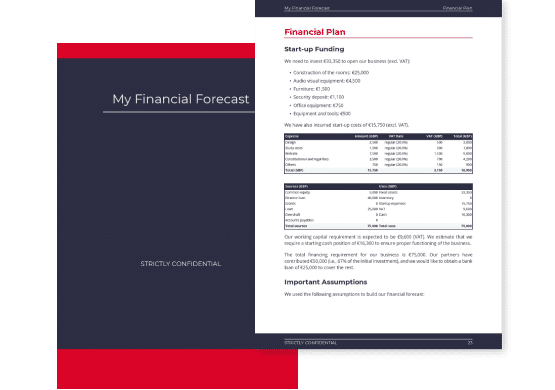
When seeking financing, your forecast will be incorporated into your business plan, which is the document you will use to present your business idea to financial partners. We'll come back to the business plan in more detail later in this guide.
Creating and updating your bottled water brand's forecast is an ongoing process. Indeed, having up-to-date financial projections is the only way to maintain visibility over your company's future cash flow and cash position.
Forecasting is, therefore, the financial management tool that will be with you throughout the life of your company. Once you've started trading, you'll need to regularly compare the difference between your actual accounts and your forecasts, and then adjust them to maintain visibility over your future cash flows.
What does a financial forecast look like?
Once ready, your bottled water brand forecast will be presented using the financial tables below.
The forecasted profit & loss statement
The profit & loss forecast gives you a clear picture of your business’ expected growth over the first three to five years, and whether it’s likely to be profitable or not.
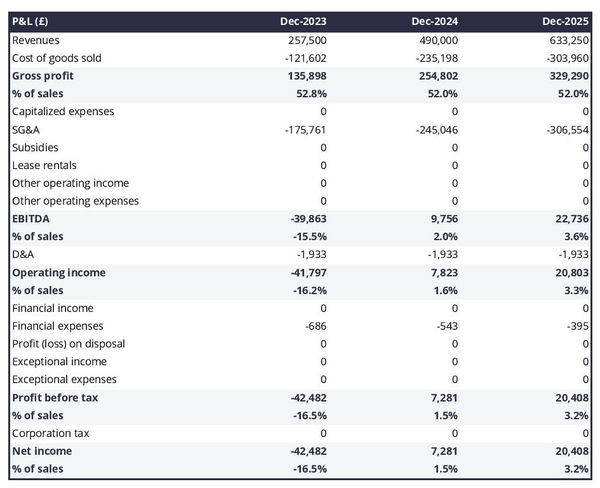
The projected balance sheet
Your bottled water brand's forecasted balance sheet enables you to assess your financial structure and working capital requirements.
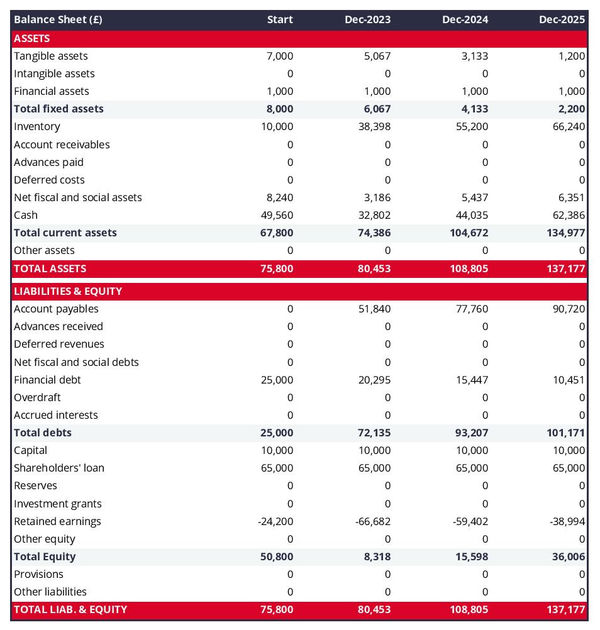
The projected cash flow statement
A projected cash flow statement to start a bottled water brand is used to show how much cash the business is expected to generate or consume over the first three years.
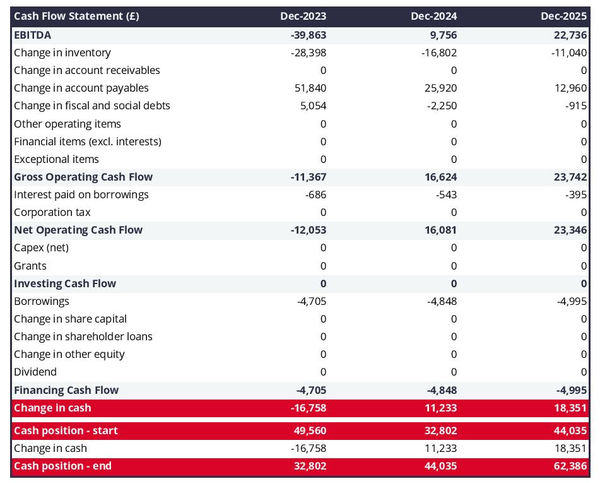
What is the best financial forecasting tool for starting your bottled water brand?
The simplest and easiest way to create your bottled water brand's projections is to use professional online financial forecasting software such as the one we offer at The Business Plan Shop.
There are several advantages to using specialised software:
- You can easily create your financial forecast by letting the software take care of the financial calculations for you without errors
- You have access to complete financial forecast templates
- You get a complete financial forecast ready to be sent to your bank or investors
- The software helps you identify and correct any inconsistencies in your figures
- You can create scenarios to stress-test your forecast's main assumptions to stress-test the robustness of your business model
- After you start trading, you can easily track your actual financial performance against your financial forecast, and recalibrate your forecast to maintain visibility on your future cash flows
- You have a friendly support team on standby to assist you when you are stuck
If you are interested in this type of solution, you can try our forecasting software for free by signing up here.
How do I choose a name and register my bottled water brand?
Now that your project of launching a bottled water brand is starting to take shape, it's time to look at the name of your business.
Finding the name itself is generally fairly easy. The difficulty lies in registering it.
To prevent this guide from being too long, we won't go into all the criteria you need to take into account when choosing a striking name for your bottled water brand. However, try to choose a name that is short and distinctive.
Once you have a name that you like, you need to check that it is available, because you cannot use a name that is identical or similar to that of a competitor: this type of parasitic behaviour is an act of unfair competition for which you risk being taken to court by your competitors.
To avoid any problems, you will need to check the availability of the name:
- Your country's company register
- With the trademark register
- With a domain name reservation company such as GoDaddy
- On an Internet search engine
If the desired name is available, you can start the registration process.
It is common to want to use the trading name as the name of the company, and to have a domain name and a registered trademark that also correspond to this name: Example ® (trading name protected by a registered trademark), Example LTD (legal name of the company), example.com (domain name used by the company).
The problem is that each of these names has to be registered with a different entity, and each entity has its own deadlines:
- Registering a domain name is immediate
- Registering a trademark usually takes at least 3 months (if your application is accepted)
- The time taken to register a new business depends on the country, but it's generally quite fast
How do I go about it?
Well, you have two choices:
- Complete all registrations at the same time and cross your fingers for a smooth process.
- Make sure to secure the domain names and trademarks. Once that's done, wait for confirmation of a successful trademark registration before moving on to register the company.
At The Business Plan Shop, we believe it's essential to prioritize securing your domain names and trademarks over the business name. This is because you have the flexibility to use a different trading name than your legal business name if needed.
Regardless, we suggest discussing this matter with your lawyer (see below in this guide) before making any decisions.
What corporate identity do I want for my bottled water brand?
The following step to start a bottled water brand is to define your company's visual identity.
Visual identity is part of the DNA of your bottled water brand: it makes you recognizable and recognized by your customers, and helps you stand out from the competition. It also helps convey your values, notably through the choice of colors that identify the company.
Creating your business's visual identity yourself is entirely possible: there are several online tools that let you generate color palettes, choose typography and even generate logos.
However, we advise you to delegate this task to a designer or a communications agency for a professional result.
Your corporate identity will include the following elements:
- Your business logo
- Your brand guidelines
- Your business cards
- Design and theme of your website
Logo
Your bottled water brand's logo serves as a quick identifier for your company. It will be featured on all your communication platforms (website, social networks, business cards, etc.) and official documents (invoices, contracts, etc.).
Beyond its appearance, your logo should be easy to use on any type of support and background (white, black, gray, colored, etc.). Ideally, it should be easy to use in a variety of colors.
Brand guidelines
One of the challenges when starting a bottled water brand is to ensure a consistent brand image wherever your company is visible.
This is the role of your company's brand guidelines, which defines the typography and colors used by your brand and thus acts as the protector of your brand image.
Typography refers to the fonts used (family and size). For example, Trebuchet in size 22 for your titles and Times New Roman in size 13 for your texts.
The colors chosen to represent your brand should typically be limited to five (or fewer):
- The main colour,
- A secondary colour (the accent),
- A dark background colour (blue or black),
- A grey background colour (to vary from white),
- Possibly another secondary colour.
Business cards
Classic but a must-have, your business cards will be at your side to help you easily communicate your contact details to your founders, customers, suppliers, recruitment candidates, etc.
In essence, they should feature your logo and adhere to the brand guidelines mentioned earlier.
Website theme
Likewise, the theme of your bottled water brand website will integrate your logo and follow the brand guidelines we talked about earlier.
This will also define the look and feel of all your site's graphic elements:
- Buttons
- Menus
- Forms
- Banners
- Etc.
Understanding the legal and regulatory steps involved in opening a bottled water brand
The next step in opening a bottled water brand is to take the necessary legal and regulatory steps.
We recommend that you be accompanied by a law firm for all of the steps outlined below.
Registering a trademark and protecting the intellectual property of your bottled water brand
The first step is to protect your company's intellectual property.
As mentioned earlier in this guide, you have the option to register a trademark. Your lawyer can assist you with a thorough search to ensure your chosen trademark is unique and doesn't conflict with existing ones and help select the classes (economic activities) and jurisdictions in which to register your trademark.
Your lawyer will also be able to advise you on other steps you could take to protect your company's other intellectual property assets.
Drafting the contractual documents for your bottled water brand
Your bottled water brand will rely on a set of contracts and legal documents for day-to-day operations.
Once again, we strongly recommend that you have these documents drawn up by a lawyer.
Your exact needs will depend on the country in which you are launching your bottled water brand and the size of the company you are planning.
However, you may wish to consider the following documents at a minimum:
- Employment contracts
- General terms and conditions of sale
- General terms and conditions of use for your website
- Privacy Policy for your website
- Cookie Policy for your website
- Invoices
- Etc.
Applying for licences and permits and registering for various taxes
The licenses and permits needed for your business will depend on the country where you are establishing it. Your lawyer can guide you on the regulations relevant to your activity.
Similarly, your chartered accountant will be able to help you register for taxes and take the necessary steps to comply with the tax authorities.
How do I write a business plan for a bottled water brand?
Once you've completed all the above steps, you can start writing the business plan for your bottled water brand.
What is a bottled water brand's business plan?
The business plan is a document containing:
- The financial forecast (discussed earlier in this guide), highlighting the project's financing requirements and profitability potential,
- A written presentation, which presents your project in detail and provides the necessary context for the reader to assess the relevance and coherence of your forecast.
The business plan is particularly important: it will help you validate your business idea and ensure its coherence and financial viability.
But it's also the document you'll send to your bank and potential investors to present your plan to open a bottled water brand and make them want to support you.
So it's best to draw up a professional, reliable and error-free business plan.
How to write a business plan for my bottled water brand?
If you're not used to writing business plans, or if you want to save time, a good solution is to use an online business plan software for startups like the one we offer at The Business Plan Shop.
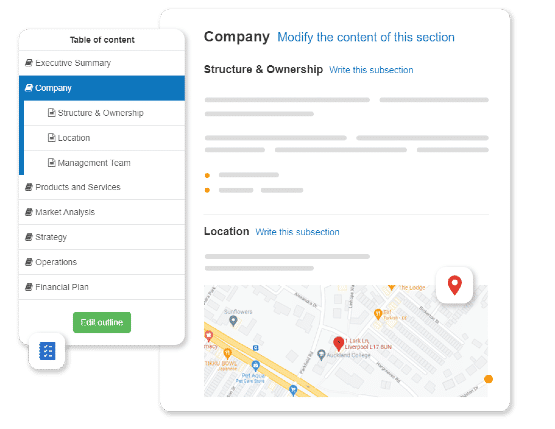
Using The Business Plan Shop to create a business plan for a bottled water brand has several advantages:
- You can easily create your financial forecast by letting the software take care of the financial calculations for you without errors
- You are guided through the writing process by detailed instructions and examples for each part of the plan
- You can access a library of dozens of complete startup business plan samples and templates for inspiration
- You get a professional business plan, formatted and ready to be sent to your bank or investors
- You can create scenarios to stress test your forecast's main assumptions
- You can easily track your actual financial performance against your financial forecast by importing accounting data
- You can easily update your forecast as time goes by to maintain visibility on future cash flows
- You have a friendly support team on standby to assist you when you are stuck
Interested? If so, you can try The Business Plan Shop for free by signing up here.
Financing the launch of your bottled water brand
Once your business plan has been written, you’ll need to think about how you might secure the funding required to open your bottled water brand.
The amount of initial financing required will of course depend on the size of your bottled water brand and the country in which you wish to set up.
Financing your startup will probably require you to obtain a combination of equity and debt, which are the primary financial resources available to businesses.
Equity funding
Equity refers to the amount of money invested in your bottled water brand by founders and investors and is key to starting a business.
Equity provides your company with stable, long-term (often permanent) capital. It also demonstrates the commitment of the company's owners to the project, since these sums can be lost in the event of bankruptcy.
Because the equity invested by the founders may be lost if the project doesn't succeed, it signals to investors and other financial institutions the founders' strong belief in the business's chances of success and might improve the likelihood of obtaining further funding as a result.
In terms of return on investment, equity investors receive dividends paid by the company (provided it is profitable) or realise capital gains by reselling their shares (provided they find a buyer interested in the company).
Equity investors are, therefore, in a very risky position. They stand to lose their initial investment in the case of bankruptcy and will only obtain a return on investment if the business manages to be profitable or sold. On the other hand, they could generate a very high return if the venture is a financial success.
Given their position, equity investors are usually looking to invest in business ventures with sufficient growth and profitability potential to offset their risk.
From the point of view of the company and its creditors, equity reduces risk, since equity providers finance the company and are only remunerated in the event of success.
From a technical standpoint, equity consists of:
- Share capital and premiums: which represent the amount invested by the shareholders. This capital is considered permanent as it is non-refundable. In return for their investment, shareholders receive shares that entitle them to information, decision-making power (voting in general assembly), and the potential to receive a portion of any dividends distributed by the company.
- Director loans: these are examples of non-permanent capital advanced to the company by the shareholders. This is a more flexible way of injecting some liquidity into your company than doing so as you can repay director loans at any time.
- Reserves: these represent the share of profits set aside to strengthen the company's equity. Allocating a percentage of your profits to the reserves can be mandatory in certain cases (legal or statutory requirement depending on the legal form of your company). Once allocated in reserves, these profits can no longer be distributed as dividends.
- Investment grants: these represent any non-refundable amounts received by the company to help it invest in long-term assets.
- Other equity: which includes the equity items which don't fit in the other categories. Mostly convertible or derivative instruments. For a small business, it is likely that you won't have any other equity items.
The main sources of equity are as follows:
- Personal contribution from the founders' savings.
- Private investors: business angels, friends and family.
- Crowdfunding campaigns to find investors or collect donations (usually in exchange for a gift).
- Government initiatives such as loans on favourable terms to help partners build up their start-up capital.
Debt funding
Another option for partially funding your bottled water brand is to borrow.
By definition, debt works in the opposite way to equity:
- Debt needs to be repaid, whereas equity is permanent.
- Lenders get a contractually guaranteed return, whereas equity investors only generate a return if the company is a success.
When a company borrows money, it agrees to pay interest and repay the borrowed principal according to a pre-established schedule. Therefore, lenders make money regardless of whether the company is profitable and their main risk is if the company goes bankrupt.
To limit their risk, lenders are usually conservative and cautious in their approach. They only finance projects where they are confident that they will be repaid in full.
Companies borrow in two ways:
- Against their assets: this is the most common way of borrowing. The bank finances a percentage of the price of an asset (a vehicle or a building, for example) and takes the asset as collateral. If the company cannot repay, the bank seizes the asset and sells it to limit its losses.
- Against their future cash flows: the bank evaluates the company's financial forecast to estimate its borrowing capacity and assesses the conditions (amount, interest rate, term, etc.) on which it is prepared to lend, taking into account the credit risk posed by the company.
It's difficult to borrow against future cash flow when setting up a bottled water brand, because the business doesn't yet have historical data to reassure lenders about the credibility of the forecasted cash flows.
Borrowing against assets is, therefore, often the only option available to entrepreneurs. What's more, the assets that can be financed with this option must be easy to resell, in the unfortunate event that the bank is forced to seize them, which may limit your options even further.
In terms of possible sources of borrowing, the main sources here are banks and credit institutions. Bear in mind, however, that each institution is different, both in terms of the risk it is prepared to accept and in terms of how the risk of your project will be perceived and what items it will agree to finance.
In some countries, it is also possible to borrow from private investors (directly or via crowdlending platforms) or other companies, but not everywhere.
Things to remember about financing a bottled water brand
There are various ways you can raise the initial financing you need to open your bottled water brand. A minimum amount of equity will be needed to give the project credibility, and bank financing can be sought to complete the package.
Launching your bottled water brand and monitoring progress against your forecast
Once you’ve secured financing, you will finally be ready to launch your bottled water brand. Congratulations!
Celebrate the launch of your business and acknowledge the hard work that brought you here, but remember, this is where the real work begins.
As you know, 50% of business start-ups do not pass the five-year mark. Your priority will be to do everything to secure your business's future.
To do this, it is key to keep an eye on your business plan to ensure that you are on track to achieve your goals.
No one can predict the future with certainty, so it’s likely that your bottled water brand's financial performance will differ from what you predicted in your forecast.
This is why it is recommended to make several forecasts:
- A base case (most likely)
- An optimistic scenario
- And a pessimistic scenario to test the robustness of your financial model
If you follow this approach, your numbers will hopefully be better than your optimistic case and you can consider accelerating your expansion plans. That’s what we wish you anyway!
If, unfortunately, your figures are below your base case (or worse than your pessimistic case), you will need to quickly put in place corrective actions, or consider stopping the activity.
The key, in terms of decision-making, is to regularly compare your real accounting data to your bottled water brand's forecast to:
- Measure the discrepancies and promptly identify where the variances with your base case come from
- Adjust your financial forecast as the year progresses to maintain visibility on future cash flow and cash position
There is nothing worse than waiting for your accountant to prepare your year-end accounts, which can take several months after the end of your financial year (up to nine months in the UK for example), to realise that the performance over the past year was well below the your base case and that your bottled water brand will not have enough cash to keep running over the next twelve months.
This is why using a financial forecasting solution that integrates with accounting software and offers actuals vs. forecast tracking out of the box, like the financial dashboards we offer at The Business Plan Shop, greatly facilitates the task and significantly reduces the risk associated with starting a business.
Key takeaways
- To open a bottled water brand you need to go through each of the 15 steps we have outlined in this guide.
- The financial forecast is the tool that will enable you to check that your project can be profitable and to estimate the investment and initial financing requirements.
- The business plan is the document that your financial partners will ask you to produce when seeking finance.
- Once you have started trading, it will be essential to keep your financial forecasts up to date in order to maintain visibility of the future cash flow of your bottled water brand.
- Leveraging a financial planning and analysis platform that seamlessly integrates forecasts, business plans, and real-time performance monitoring — like The Business Plan Shop — simplifies the process and mitigates risks associated with launching a business.
We hope this practical guide has given you a better understanding of how to open a bottled water brand. Please do not hesitate to contact our team if you have any questions or if you would like to share your experience of setting up your own business.
Also on The Business Plan Shop
Do you know someone who is thinking about opening a bottled water brand? Share our guide with them!
